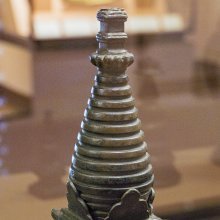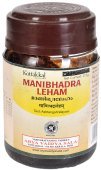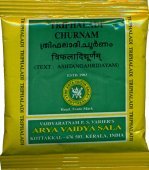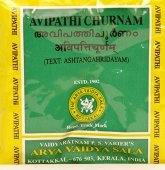Amalaka, Āmalaka, Āmālaka: 30 definitions
Introduction:
Amalaka means something in Buddhism, Pali, Hinduism, Sanskrit, the history of ancient India, Marathi, Hindi, biology. If you want to know the exact meaning, history, etymology or English translation of this term then check out the descriptions on this page. Add your comment or reference to a book if you want to contribute to this summary article.
Alternative spellings of this word include Amalak.
Images (photo gallery)
In Hinduism
Natyashastra (theatrics and dramaturgy)
Source: archive.org: The mirror of gesture (abhinaya-darpana)One of the Hands indicating Trees.—Āmalaka, the Samyama Nayaka hand, i.e., the forefinger and second finger together in the middle of the palm, the rest extended.

Natyashastra (नाट्यशास्त्र, nāṭyaśāstra) refers to both the ancient Indian tradition (shastra) of performing arts, (natya—theatrics, drama, dance, music), as well as the name of a Sanskrit work dealing with these subjects. It also teaches the rules for composing Dramatic plays (nataka), construction and performance of Theater, and Poetic works (kavya).
Shilpashastra (iconography)
Source: Shodhganga: The significance of the mūla-beras (śilpa)Āmalaka (आमलक, “dome”) refers to the “dome” on the crown of the Hindu temple.—The prāsāda (a three-storeyed palace) is almost completely a solid mass on whose multi-buttressed walls the images are displayed. The finial/the culminating portion of a pinnacle is raised above the body of the prāsāda as it is on the crown of the temple known as āmalaka (dome). It is a ribbed flattened top surmounted by a kalaśa (ornamental pot found in finials and capitals), topped by a finial and a banner. It is also known as harmya (a beautiful palace) in South Indian temples.

Shilpashastra (शिल्पशास्त्र, śilpaśāstra) represents the ancient Indian science (shastra) of creative arts (shilpa) such as sculpture, iconography and painting. Closely related to Vastushastra (architecture), they often share the same literature.
Ayurveda (science of life)
Dietetics and Culinary Art (such as household cooking)
Source: Shodhganga: Dietetics and culinary art in ancient and medieval IndiaĀmalaka (आमलक) refers to the “Emblic myrobalan” and represents a type of fruit-bearing plant, according to the Arthaśāstra II.15.19, and is commonly found in literature dealing with the topics of dietetics and culinary art, also known as Pākaśāstra or Pākakalā.—We can see the description of flowering and fruit bearing plants in Ṛgveda. But we come across the specific names of them only in the later Saṃhita and Brāhmaṇa literature. [...] Karamarda, parūṣaka, cūta (a variety of mango), Emblic myrobalan (āmalaka), Citrus medica, jujube, rose apple (jambu), cucumber (urvāruka), palm fruit (tālaphala), rājādana, pomegranate and jack fruit are referred to in Arthaśāstra. [...] Bhela especially recommends the use of āmalaka before food, hārītakī after the food and vibhītakī after the digestion of the food.
Āmalaka or “gooseberry” is mentioned as being beneficial (hita) to the body according to the 17th century Bhojanakutūhala in the dravyaguṇāguṇa-kathana, which contains the discussions on different food articles and their dietetic effects according to the prominent Ayurvedic treatises. Here In the Phala (fruits) group Āmalaka (gooseberry) is mentioned as beneficial to the body (hita).
Āmalaka or “gooseberry” is mentioned in a list of potential causes for indigestion.—A complete section in Bhojanakutūhala is devoted for the description of agents that cause indigestion [viz., āmalaka (gooseberry)]. These agents consumed on a large scale can cause indigestion for certain people. The remedies [viz., bakula fruit (Mimusops elengi)] for these types of indigestions are also explained therewith.
Kalpa (Formulas, Drug prescriptions and other Medicinal preparations)
Source: Ancient Science of Life: Yogaśataka of Pandita VararuciĀmalaka (आमलक) refers to a medicinal plant known as Phyllanthus emblica Linn., and is mentioned in the 10th century Yogaśataka written by Pandita Vararuci.—The Yogaśataka of Pandita Vararuci is an example of this category. This book attracts reader by its very easy language and formulations which can be easily prepared and have small number of herbs (viz., Āmalaka). It describes only those formulations which are the most common and can be used in majority conditions of diseases.
Simple Rasāyana (rejuvenative drugs) such as Āmalaka-rasāyana (prepared from powder of fruits of Phyllanthus emblica Linn.), Rasāyana powder which is a mixture of powders of Guḍūcī, Gokṣura (Tribulus terrestris Linn.) and Āmalaka etc., are described for rejuvenation. Powder of Āmalaka triturated with its own juice and mixed with Pippalī (Piper longum Linn.), honey and sugar is fomented for one year. According to the author if a person uses this for one year continuously it will give him blackish hairs, improves intellect, memory power, speech, strength and mental power.
Source: Shodhganga: Edition translation and critical study of yogasarasamgrahaĀmalaka (आमलक) refers to the medicinal plant known as “Phyllanthus emblica Linn.” and is dealt with in the 15th-century Yogasārasaṅgraha (Yogasara-saṅgraha) by Vāsudeva: an unpublished Keralite work representing an Ayurvedic compendium of medicinal recipes. The Yogasārasaṃgraha [mentioning āmalaka] deals with entire recipes in the route of administration, and thus deals with the knowledge of pharmacy (bhaiṣajya-kalpanā) which is a branch of pharmacology (dravyaguṇa).
Toxicology (Study and Treatment of poison)
Source: Shodhganga: Kasyapa Samhita—Text on Visha ChikitsaĀmalaka (आमलक) (or Āmalakī) is the name of an ingredient used in the treatment of snake-bites such as those caused by the Kṛṣṇamaṇḍalī-snakes, according to the Kāśyapa Saṃhitā: an ancient Sanskrit text from the Pāñcarātra tradition dealing with both Tantra and Viṣacikitsā—an important topic from Āyurveda which deals with the study of Toxicology (Viṣavidyā or Sarpavidyā).—Accordingly, one of the treatments is mentioned as follows: “A compound of a measure of powdered kernel of Āmalakī (Myrobalan), Guñjā and dry ginger boiled in water to one eigth quantity mixed with ghee must be given to b the victim as a drink”.
Unclassified Ayurveda definitions
Source: eJournal of Indian Medicine: Jajjaṭa’s Nirantarapadavyākhyā and Other Commentaries on the CarakasaṃhitāĀmalaka (आमलक) refers to Emblica officinalis Gaertn., and is a medicinal plant mentioned in the 7th-century Nirantarapadavyākhyā by Jejjaṭa (or Jajjaṭa): one of the earliest extant and, therefore, one of the most important commentaries on the Carakasaṃhitā.—Synonym of Āmalaka: Āmalakī.—(Cf. Glossary of Vegetable Drugs in Bṛhattrayī 36, Singh and Chunekar, 1999).—Cf. Phyllanthus emblica Linn. (Cf. Indian Medicinal Plants 4:256, Arya Vaidya Sala, 1993-96.).—Note: Emblica officinalis Gaertn. is a synonym of Phyllanthus emblica L.—(Cf. The Plant List, A Working List of All Plant Species, Royal Botanic Gardens, Kew and Missouri Botanical Garden).

Āyurveda (आयुर्वेद, ayurveda) is a branch of Indian science dealing with medicine, herbalism, taxology, anatomy, surgery, alchemy and related topics. Traditional practice of Āyurveda in ancient India dates back to at least the first millenium BC. Literature is commonly written in Sanskrit using various poetic metres.
Vastushastra (architecture)
Source: Shodhganga: Elements of Art and Architecture in the Trtiyakhanda of the Visnudharmottarapurana (vastu)1) Āmalaka (आमलक) is used as an ingredient of a mixture of Vajralepa (“a special kind of hard cement”) which was used in the construction of a Temple and as a binding agent for joining bricks, according to the Viṣṇudharmottarapurāṇa, an ancient Sanskrit text which (being encyclopedic in nature) deals with a variety of cultural topics such as arts, architecture, music, grammar and astronomy. In the Viṣṇudharmottarapurāṇa, five procedures of preparing the vajralepa are suggested.—In the second variety, the mixture of lākṣā, kunduru, gṛhadhūma the middle portion of kapittha and bilva, nāgaphala, balā, madhuka, kiñjāpa, madana, mañjīṣṭhā, āmalaka and sarja should be taken.
2) Āmalaka (आमलक) or Āmalakasāraka refers to a “massive circular stone” which is a part of the Kūṭa part of the Hindu Temple.—[...] Kūṭa (“top portion of the temple”) can be classified into three divisions having three āmalakasārakas. Āmalakasāraka or āmalaka is a massive circular stone which is figured as the crowning member of the śikhara or the peak of the temple.

Vastushastra (वास्तुशास्त्र, vāstuśāstra) refers to the ancient Indian science (shastra) of architecture (vastu), dealing with topics such architecture, sculpture, town-building, fort building and various other constructions. Vastu also deals with the philosophy of the architectural relation with the cosmic universe.
General definition (in Hinduism)
Source: Academia.edu: Unity and Gravity of an elemental ArchitectureEmbodied up the corners of the curvature of the shrine and used as its crowning member, ribbed stones called Āmalakas—the myrobalan fruit—ascend,supported by their own pillared kūṭa cages. They grow upwards and proliferate, as if toward their final realization at the pinnacle. It is this seed—placed beyond Ether (ākāśa), not in Air (vāyu)—that may one day flower at the tower’s top.
In Buddhism
Tibetan Buddhism (Vajrayana or tantric Buddhism)
Source: academia.edu: The Structure and Meanings of the Heruka MaṇḍalaĀmalaka (आमलक) refers to one of the eight trees (vṛkṣa) of the Medinīcakra, according to the 10th century Ḍākārṇava chapter 15. Accordingly, the medinīcakra refers to one of the three divisions of the dharma-puṭa (‘dharma layer’), situated in the Herukamaṇḍala. Āmalaka is associated with the charnel ground (śmaśāna) named Vidveṣaṇa; with the female world-guardian (lokapālinī) named Ṛṣī; with a female serpent (nāginī) and with a female cloud (meghinī).

Tibetan Buddhism includes schools such as Nyingma, Kadampa, Kagyu and Gelug. Their primary canon of literature is divided in two broad categories: The Kangyur, which consists of Buddha’s words, and the Tengyur, which includes commentaries from various sources. Esotericism and tantra techniques (vajrayāna) are collected indepently.
India history and geography
Source: Shodhganga: Cultural history as g leaned from kathasaritsagaraAmalaka is the name of a tree mentioned in the Kathasaritsagara by Somadeva (10th century A.D).—Amlaka is known for its tasty fruits. A dish of amalaka is mentioned.
Somadeva mentions many rich forests, gardens, various trees (e.g., Amalaka), creepers medicinal and flowering plants and fruit-bearing trees in the Kathasaritsagara. Travel through the thick, high, impregnable and extensive Vindhya forest is a typical feature of many travel-stories. Somadeva’s writing more or less reflects the life of the people of Northern India during the 11th century. His Kathasaritsagara (‘ocean of streams of story’), mentioning Amalaka, is a famous Sanskrit epic story revolving around prince Naravahanadatta and his quest to become the emperor of the vidyadharas (celestial beings).
Source: Project Gutenberg: Castes and Tribes of Southern India, Volume 1Amalaka or Usiri is one of the exogamous septs (divisions) among the Komatis (a trading caste of the Madras Presidency). Amalaka refers to the plant Amalaka or Usiri (Phyllanthus Emblica). The Komatis are said to have originally lived, and still live in large numbers on the banks of the Godavari river. One of the local names thereof is Gomati or Gomti, and the Sanskrit Gomati would, in Telugu, become corrupted into Komati. The sub-divisions are split up into septs (viz., Amalaka), which are of a strictly exogamous character.

The history of India traces the identification of countries, villages, towns and other regions of India, as well as mythology, zoology, royal dynasties, rulers, tribes, local festivities and traditions and regional languages. Ancient India enjoyed religious freedom and encourages the path of Dharma, a concept common to Buddhism, Hinduism, and Jainism.
Biology (plants and animals)
Source: Wisdom Library: Local Names of Plants and DrugsAmalaka in the Kannada language is the name of a plant identified with Phyllanthus emblica L. from the Phyllanthaceae (Amla) family having the following synonyms: Emblica officinalis. For the possible medicinal usage of amalaka, you can check this page for potential sources and references, although be aware that any some or none of the side-effects may not be mentioned here, wether they be harmful or beneficial to health.
Amalaka in the Sanskrit language, ibid. previous identification.
Source: Google Books: CRC World Dictionary (Regional names)Amalaka in India is the name of a plant defined with Justicia adhatoda in various botanical sources. This page contains potential references in Ayurveda, modern medicine, and other folk traditions or local practices It has the synonym Justicia adhatoda Mart. ex Nees (among others).
Example references for further research on medicinal uses or toxicity (see latin names for full list):
· The Gardeners Dictionary (1754)
· Prodr. (DC.) (1847)
· Plantae Asiaticae Rariores (Wallich) (1829)
· CIS Chromosome Information Service (1976)
· Bangladesh Journal of Botany (1990)
· Journal of Ethnopharmacology (1992)
If you are looking for specific details regarding Amalaka, for example extract dosage, health benefits, chemical composition, pregnancy safety, side effects, diet and recipes, have a look at these references.

This sections includes definitions from the five kingdoms of living things: Animals, Plants, Fungi, Protists and Monera. It will include both the official binomial nomenclature (scientific names usually in Latin) as well as regional spellings and variants.
Languages of India and abroad
Pali-English dictionary
Source: BuddhaSasana: Concise Pali-English Dictionaryāmalaka : (nt.) emblic myrobalan, Phyllanthus Emblica.
Source: Sutta: The Pali Text Society's Pali-English DictionaryĀmalaka, (cp. Sk. āmalaka) emblic myrobalan, Phyllanthus Emblica Vin.I, 201, 278; II, 149 (°vaṇṭika pīthu); S.I, 150; A.V, 170; Sn.p. 125 (°matti); J.IV, 363; V, 380 (as v. l. for T. āmala); Miln.11; DhA.I, 319; VvA.7. (Page 104)

Pali is the language of the Tipiṭaka, which is the sacred canon of Theravāda Buddhism and contains much of the Buddha’s speech. Closeley related to Sanskrit, both languages are used interchangeably between religions.
Marathi-English dictionary
Source: DDSA: The Molesworth Marathi and English Dictionaryāmalaka (आमलक).—m (S) A tree, Phyllanthus emblica or Emblic myrobalan. 2 n Its fruit. Ex. turaṭa vāṭē ā0 || pari puḍhēṃ gōḍī disē adhika ||
Source: DDSA: The Aryabhusan school dictionary, Marathi-Englishāmalaka (आमलक).—m A kind of tree. n Its fruit (āvaḷā).
Marathi is an Indo-European language having over 70 million native speakers people in (predominantly) Maharashtra India. Marathi, like many other Indo-Aryan languages, evolved from early forms of Prakrit, which itself is a subset of Sanskrit, one of the most ancient languages of the world.
Sanskrit dictionary
Source: DDSA: The practical Sanskrit-English dictionaryĀmalaka (आमलक).—
1) The tree, Emblic Myrobalan, Emblica Officinalis Gaertn (Mar. āṃvaḷā).
2) Name of another tree (vāsaka).
-kam Fruit of the Emblic Myrobalan; बदरामलकाम्रदाडिमानाम् (badarāmalakāmradāḍimānām) Bv.2.8.
Derivable forms: āmalakaḥ (आमलकः).
See also (synonyms): āmalakī.
--- OR ---
Āmālaka (आमालक).—A hill-station.
Derivable forms: āmālakaḥ (आमालकः).
Source: Cologne Digital Sanskrit Dictionaries: Shabda-Sagara Sanskrit-English DictionaryĀmalaka (आमलक).—mfn.
(-kaḥ-kī-kaṃ) Emblic myrobalan, (Phyllanthus emblica.) m.
(-kaḥ) Another plant, (Justicia adhenatoda, &c.) n.
(-kaṃ) The fruit of the myrobalan. E. āṅ and mal to hold, vun aff. fem. ṅīṣ having all medicinal virtues.
--- OR ---
Āmālaka (आमालक).—mn.
(-kaḥ-kaṃ) Land near a mountain.
Source: Cologne Digital Sanskrit Dictionaries: Benfey Sanskrit-English DictionaryĀmalaka (आमलक).—m., f. kī, and n. Emblic myrobalan.
Source: Cologne Digital Sanskrit Dictionaries: Cappeller Sanskrit-English DictionaryĀmalaka (आमलक).—[masculine] ī [feminine] the Myrobalan tree; [neuter] its fruit.
Source: Cologne Digital Sanskrit Dictionaries: Monier-Williams Sanskrit-English Dictionary1) Āmalaka (आमलक):—mf(ī). ([gana] gaurādi, [Pāṇini 4-1, 41]) Emblic Myrobalan, Emblica Officinalis Gaertn.
2) n. the fruit of the Emblic Myrobalan, [Mahābhārata; Suśruta; Chāndogya-upaniṣad] etc.
3) m. another plant, Gendarussa Vulgaris, [cf. Lexicographers, esp. such as amarasiṃha, halāyudha, hemacandra, etc.]
Source: Cologne Digital Sanskrit Dictionaries: Yates Sanskrit-English Dictionary1) Āmalaka (आमलक):—[ā-malaka] (kaḥ-kaṃ) 1. m. n. Emblic myrobalan. n. Its fruit.
2) Āmālaka (आमालक):—[āmā+laka] (kaḥ-kaṃ) 1. m. n. Land near a mountain; a valley.
Source: DDSA: Paia-sadda-mahannavo; a comprehensive Prakrit Hindi dictionary (S)Āmalaka (आमलक) in the Sanskrit language is related to the Prakrit words: Āmala, Āmalaga, Āmalaya.
[Sanskrit to German]
Sanskrit, also spelled संस्कृतम् (saṃskṛtam), is an ancient language of India commonly seen as the grandmother of the Indo-European language family (even English!). Closely allied with Prakrit and Pali, Sanskrit is more exhaustive in both grammar and terms and has the most extensive collection of literature in the world, greatly surpassing its sister-languages Greek and Latin.
Hindi dictionary
Source: DDSA: A practical Hindi-English dictionaryĀmalaka (आमलक) [Also spelled amalak]:—(nm) see [āṃvalā].
...
Kannada-English dictionary
Source: Alar: Kannada-English corpusĀmalaka (ಆಮಲಕ):—
1) [noun] the tree Emblica officinalis of Euphorbiaceae family.
2) [noun] its fruit; Emblic myrobalan.
--- OR ---
Āmaḷaka (ಆಮಳಕ):—[noun] = ಆಮಲಕ [amalaka].
Kannada is a Dravidian language (as opposed to the Indo-European language family) mainly spoken in the southwestern region of India.
Nepali dictionary
Source: unoes: Nepali-English DictionaryĀmalaka (आमलक):—n. 1. Bot. myrobalan; purple-leaf plum; 2. fig. something small/trivial;
Nepali is the primary language of the Nepalese people counting almost 20 million native speakers. The country of Nepal is situated in the Himalaya mountain range to the north of India.
See also (Relevant definitions)
Starts with: Amalakalpa, Amalakam, Amalakamalam, Amalakapaka, Amalakaphala, Amalakaphalavata, Amalakappa, Amalakapramana, Amalakarasayana, Amalakasaraka, Amalakasnana, Amalakasthi, Amalakavanamahatmya.
Ends with (+27): Anamalaka, Asokamalaka, Badaramalaka, Bhugolahastamalaka, Cukalamalaka, Gandamalaka, Hastamalaka, Hastatalamalaka, Hemamalaka, Jyeshthamalaka, Kalamalaka, Kamalaka, Karamalaka, Karatalamalaka, Khandamalaka, Kiramalaka, Kottamalaka, Kritamalaka, Kshudramalaka, Kuntamalaka.
Full-text (+53): Amalaki, Amala, Amalakam, Amalaga, Badaramalaka, Amalak, Karamalaka, Pracinamalaka, Yakshamalaka, Kshudramalaka, Hastamalaka, Amalar, Amalakipattra, Amarikam, Paniyamalaka, Varyamalaka, Khandamalaka, Kashthadhatriphala, Amalakipattraphala, Amalaya.
Relevant text
Search found 66 books and stories containing Amalaka, A-malaka, Ā-malaka, Āmalaka, Āmālaka, Āmaḷaka; (plurals include: Amalakas, malakas, Āmalakas, Āmālakas, Āmaḷakas). You can also click to the full overview containing English textual excerpts. Below are direct links for the most relevant articles:
Garga Samhita (English) (by Danavir Goswami)
Verse 6.3.11 < [Chapter 3 - Lord Balarāma’s Wedding]
Vastu-shastra (5): Temple Architecture (by D. N. Shukla)
Śikharottama Prāsādas (Nāgara Temples)—The evolution of Śikhara < [Chapter 12 - History of Hindu Temples (Prāsādas and Vimānas)]
Chapter 3 - The Development of the Prāsāda-vāstu
Sushruta Samhita, Volume 6: Uttara-tantra (by Kaviraj Kunja Lal Bhishagratna)
Chapter XLIX - Symptoms and Treatment of Vomiting (Chardi) < [Canto III - Kaya-chikitsa-tantra (internal medicine)]
Chapter XVII - Treatment of diseases of pupil and crystalline lens < [Canto I - Shalakya-tantra (ears, eyes, nose, mouth and throat)]
Chapter LII - Symptoms and Treatment of Cough (Kasa) < [Canto III - Kaya-chikitsa-tantra (internal medicine)]
Jain Remains of Ancient Bengal (by Shubha Majumder)
Abandoned Temples/Structural Ruins Containing Sculptural Specimens < [Chapter 5 - Jaina Architectural and Sculptural Remains]
Jain Caumukha/Caumukhi or Caturmukhas < [Chapter 6 - Iconographic Study of Jaina Sculptural Remains]
Pañca-tirthika type of Śāntinātha Sculptures < [Chapter 6 - Iconographic Study of Jaina Sculptural Remains]
Kathasaritsagara (the Ocean of Story) (by Somadeva)
Chapter LXXXI < [Book XII - Śaśāṅkavatī]
Chapter LXI < [Book X - Śaktiyaśas]
Foreword to volume 9 < [Forewords]
Bhesajjakkhandhaka (Chapter on Medicine) (by Hin-tak Sik)
Medicines (e): Fruits (Phala) < [Chapter 4 - Medicinal Substances in the Chapter on Medicine]
Related products
(+8 more products available)







